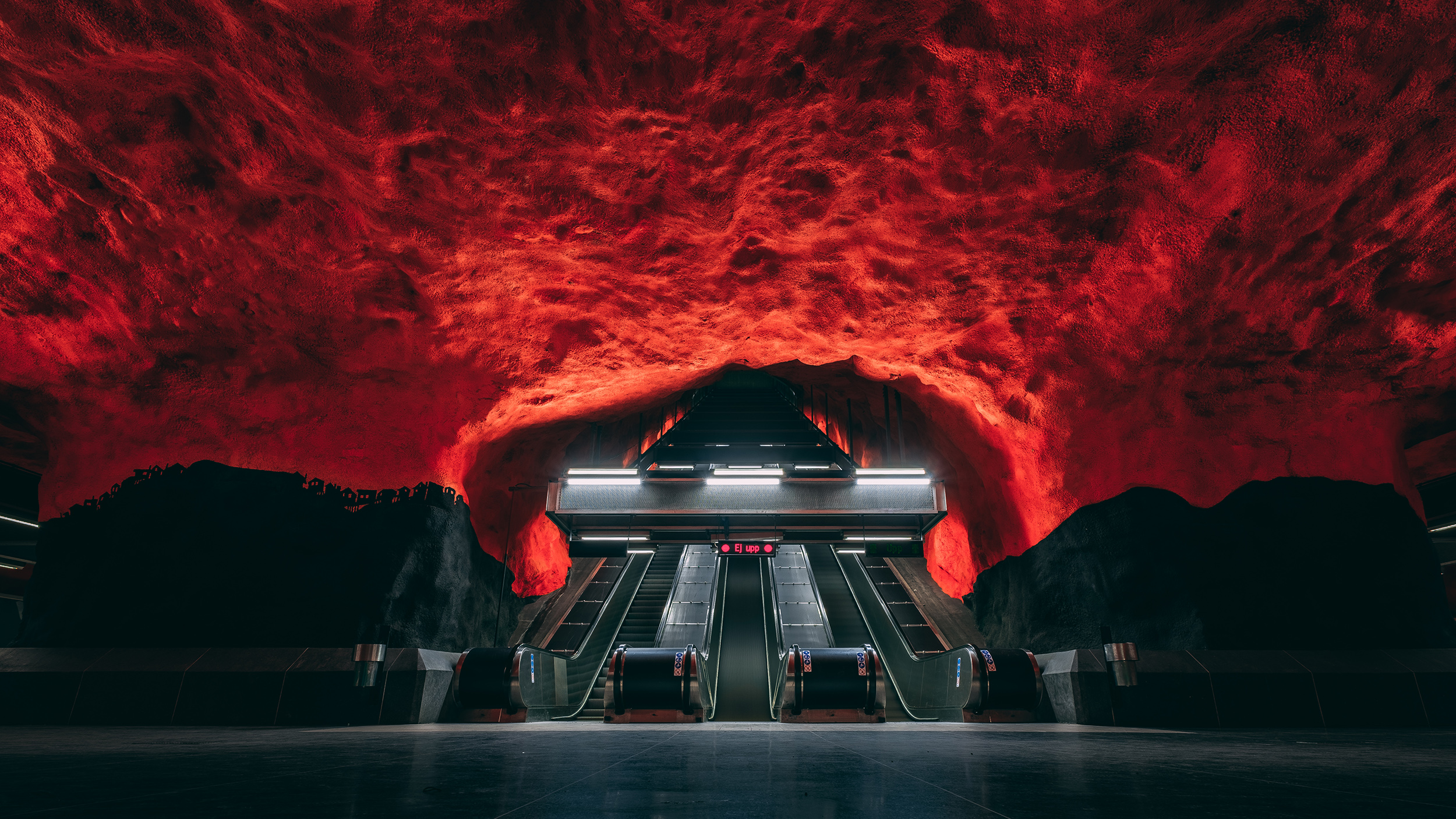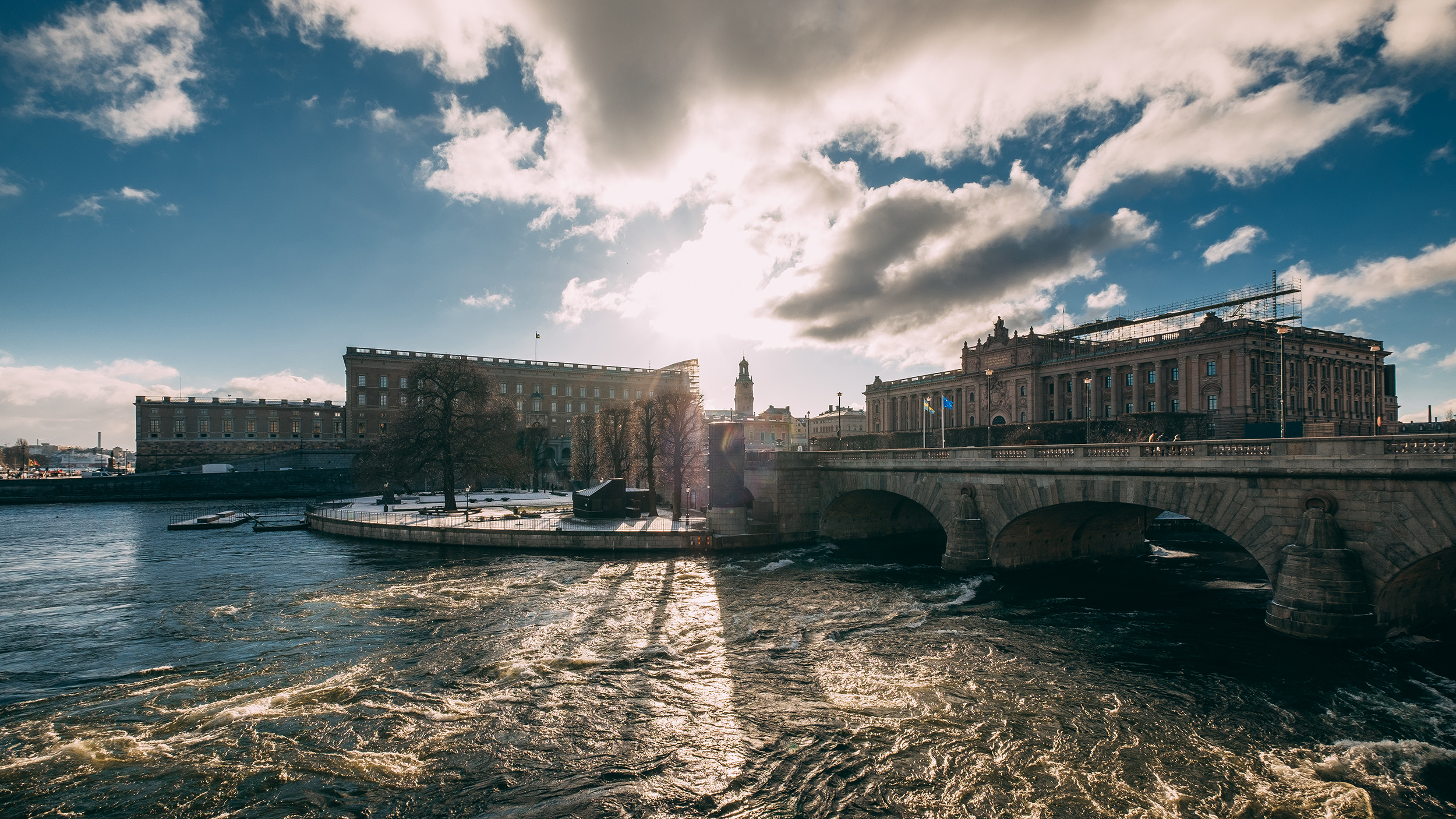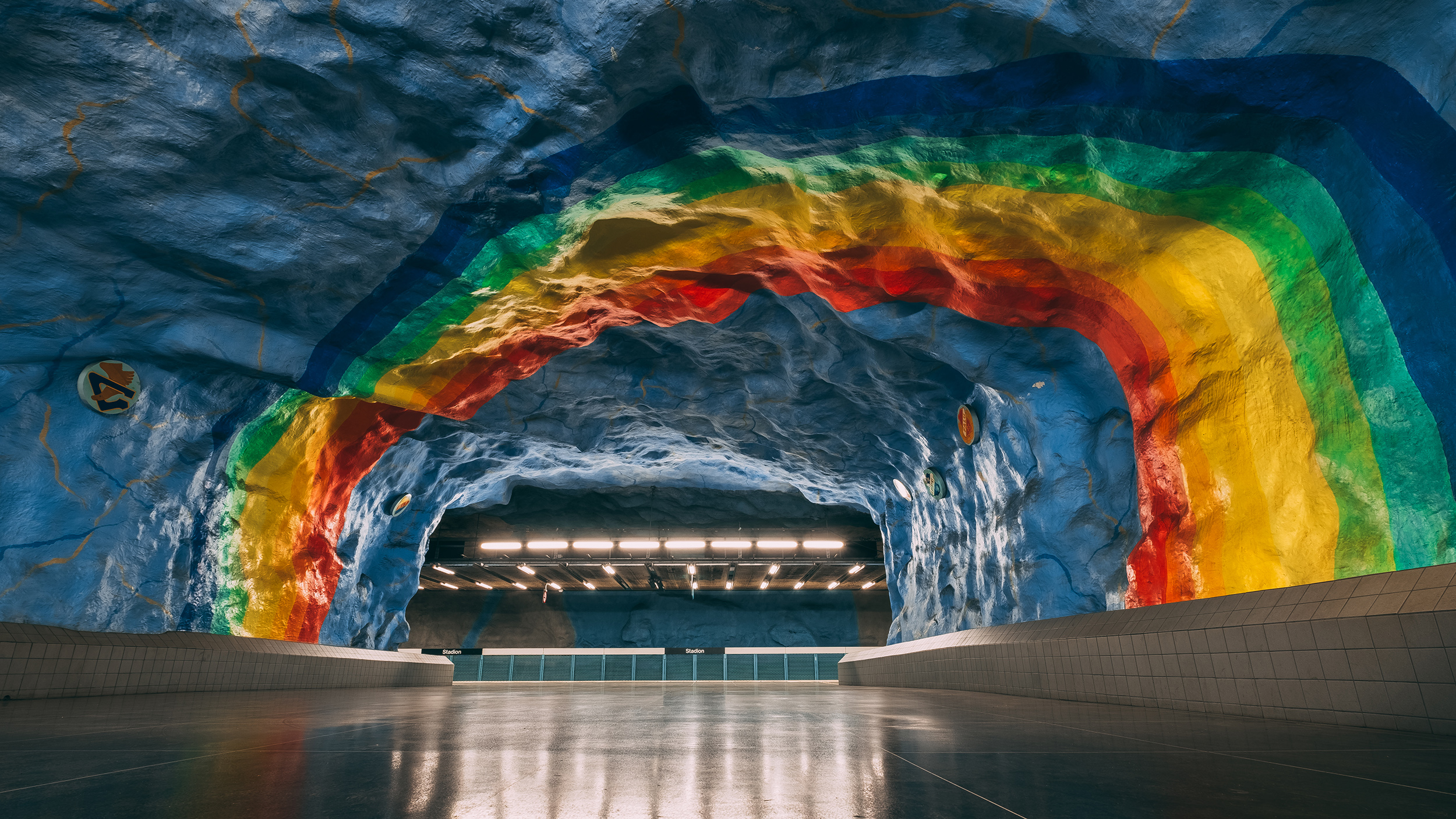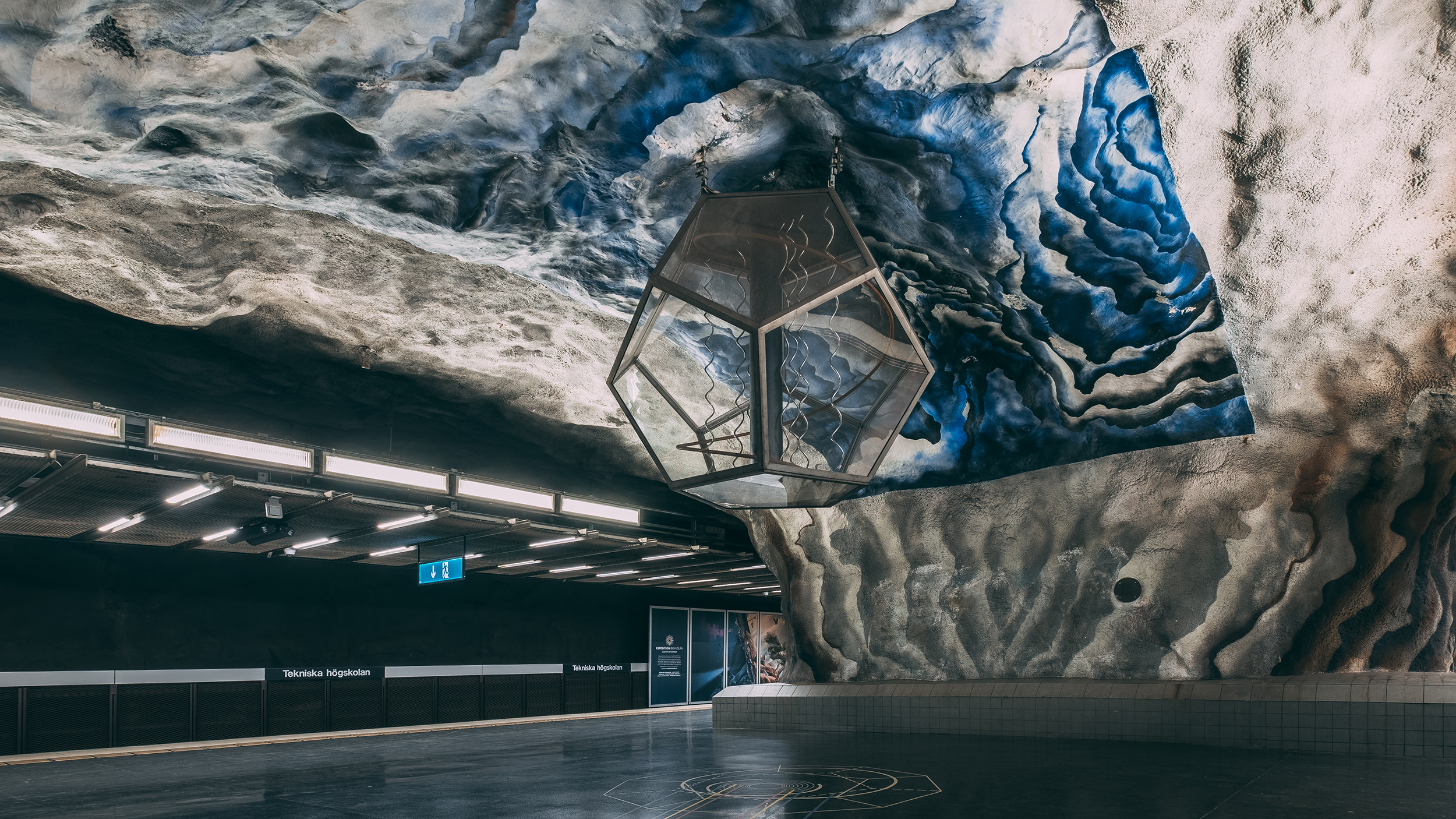When in Stockholm, go underground!
Full screen gallery below
For my birthday my girlfriend told me to get to Schiphol airport and take clothes for the weekend. So logic dictates we would be travelling to a European city for the weekend or she was just pulling my leg and getting me to think we would go somewhere. Once there it became clear that we would go to Stockholm for the weekend. I really love that city!
We arrived late Friday night and checked into our hotel room. The next day we went exploring and just walking around the city. Enjoying the fine bakeries and coffee in the different areas in Stockholm. We especially like the area Södermalm. Getting through the day was quite easy and I wanted to get to know not only Stockholm above ground, but also underground -or- the beautiful decorated metro stations.
So we took out the metro map and started planning. The next 2 hours we stayed pretty much underground. Who would have thought, it was fun and amazing!
Solna Centrum
We started at Solna Centrum, Blue line metro. This station welcomes you in a bright blood red and black entrance rolling down the escalator. This somewhat feels you are getting into dangerous, hell like, territory. However when exiting the escalator I was really amazed with the art and the impact it had.
The station of Solna Centrum opened with the first arm of the blue line in 1975. The bright green and red landscape - the green being the forest and the red an evening sun setting behind the treetops - is both timeless in its beauty, but also something that few other stations artwork is; political. After completing the walls artists Karl-Olov Björk and Anders Åberg felt they were lacking. So they continued adding various details and scenes to the forest. - source www.visitstockholm.com -
Citybanan - Odenplan
The next station we visited was Citybanan – Odenplan, Green line metro. This station has a cool entrance hall with neon lights which makes you feel you are entering a futuristic area.
Citybanan, a new track for Stockholm’s commuter trains that connects T-Centralen directly with Odenplan, was completed in 2017. Hanging down from the ceiling of Odenplan’s western entrance hallway, “Life Line” is one of Citybanans most eye-catching pieces. The piece by David Svensson consists of jagged white lines of fluorescent light, shining brightly in the tunnels. Obviously, the 400 meters of LED-lighting serves a practical purpose, but they’re also of a personal nature explains art guide, Marie Andersson. The shape of the lights was inspired by the heartbeats of the artist’s son, as shown on the CTG-monitor during the childbirth. - source www.visitstockholm.com -
Rådhuset station
Next stop Rådhuset station, Blue line metro. Rådhuset (Court House) is a rapid transit station in Kungsholmen. The station is located on the blue line between T-Centralen and Fridhemsplan.
Rådhuset station has exposed bedrock and dramatic mood lighting which gives the space the appearance of an enchanted, escalator-heavy underground grotto. Located on Kungsholmen island in central Stockholm, the station's free-flowing organic architecture both departs from and connects with the buildings standing directly above on street level including the Rådhuset (Court House), City Hall and other buttoned-up governmental edifices built in the early 20th century in National Romantic style. - source www.mnn.com -
Fotografiska
Later that evening we decided to visits Fotografiska museum. Fotografiska (The Swedish Museum of Photography) is a centre for contemporary photography in the Södermalm. Despite it actually not being a museum, it is a very big gallery let's say, it's still very nice to visit and take a look at the exhibitions that are displayed. Especially the exhibition of Åsa Sjöström - Silent Land really grabbed me. As well as the neon-esk exhibition of chinese photographer Chen Men really sparked my creativity. Take a look here, https://www.fotografiska.com/sto/en/
Vete-Katten
The next day the sun really came out and placed Stockholm in a yellow golden glow state. We started of with a very nice breakfast at Vete-Katten, do not skip this place!
Vete–Katten is a Stockholm institution – written about, spoken about and above all visited,
by most Stockholmers, both well-known and unknown, from Great Garbo’s time to the current day. The walls are steeped in flour and spices, and the sweet aroma of freshly-baked bread finds its way up into the surrounding stairwells. Someone once said that even if the house was razed to the ground, the scent would still linger in its place as a sugary cloud of cardamom. Plus the coffee is heavenly! Go there!
Kungsträdgården
The next metro stop was Kungsträdgården, Blue line metro. One of Stockholm’s most stunning stations is unsurprisingly also one of its most photographed: Kungsträdgården. Located in the middle of downtown Stockholm, it’s the terminus of the blue line, or at least until its southward extension opens in 2025.
Kungsträdgården is one of Stockholm’s oldest public parks. The name, roughly meaning “The King’s Garden”, is derived from the area’s royal history. Between 1643 and 1825 it was the site of the majestic Makalös Palace, and a beautiful French garden was built. After Makalös burned down, the site was used for military exercises. Finally, in 1875, the park landed in the care of the Stockholm City Council, which in turn opened it for the public.
Almost everything on the station tells the story of the site above ground, says Marie Andersson, subway art guide. About its history, former and current buildings. The color scheme – red, white and green – is a reference to the old French formal garden and statues around the station are actually replicas of Makalös Palace’s exterior art.
Another unique feature of Kungsträdgården is its unique fauna. The station is the only place in Northern Europe where the cave-dwelling Lessertia dentichelis-spider can be found. Presumably, the species hitched a ride on equipment and machines traveling from Southern Europe when the station was being built. Nobody knows exactly how they ended up here, continues Marie Andersson. But they seem to be thriving. I saw one just yesterday, as a matter of fact. In 2016 scientists also discovered a previously unknown fungus on the station walls with a unique DNA-structure. - source www.visitstockholm.com -
Stadion
Stadion, Red line metro. Each year Östermalms IP serves as the main festival area for the Stockholm Pride festival. By coincidence, the nearby subway station, Stadion, happens to have a beautiful rainbow in vivid colors painted against the bright blue of the station's cave walls to welcome festival goers.
The station is one of Stockholm’s first cave stations, a controversial subject when it was built in 1973, explains art guide Marie Andersson.
There were actual fears that people would associate these cave stations with the netherworld and other nasty places. So the bright blue and the rainbow serves as a reminder that there is a sky not far above.
The station’s artists, Åke Pallarp and Enno Hallek, not only wanted to bring the sky underground but also remind passengers of Stadion’s significance in sport’s history. Close by is The Stockholm Olympic Stadium, the site for the 1912 Olympics and each year between 1913 and 1965 the Swedish bandy finals. Today, Stadion is still one of Stockholm’s great arenas and regularly hosts sports events and concerts. - source www.visitstockholm.com -
Tekniska Högskolan
Tekniska Högskolan, Red line metro. Kungliga Tekniska Högskolan (KTH Royal Institute of Technology) was founded in 1827 and has since then had famous alumni like Christer Fuglesang, Dolph Lundgren, and Anette Scheibe pass its exams. In 1973 Tekniska Högskolan finally got its own subway station, to help students and professors get to their classes.
Unsurprisingly, the award-winning station (with art by Lennart Mörk) is a celebration of the scientific advances and discoveries. The most eye-catching are probably the five regular polyhedra located on the platform, each one representing one of Plato’s five elements: fire, water, air, earth, and ether.
You’ll also find representations of Copernican heliocentrism, Polhem’s mechanical alphabet, Newton’s three laws of motion and da Vinci’s attempts at creating a flying machine, explains art guide, Marie Andersson. - source www.visitstockholm.com -
Universitetet
Our metro trip was coming to an end and we headed back to the city center, but first the last stop. Universitetet, Red line metro.
Universitetet ("the University") is a Metro station in the Frescati area, close to Stockholm University (Stockholms universitet), and the Museum of Natural History. It was opened on 12 January 1975.[1]
Since the 1990s, the art on the station consists of tiles featuring Carl von Linné and the UN Declaration of Universal Human Rights. This artwork is by Belgian and Parisian artist Françoise Schein. The station includes 12 large tiles panels all dedicated to the travels of Linné around the Baltic.[2] The artist used the travels as the starting point to develop the theme of nature and the ecological problems we are all living now in the world. The work was created in Lisbon on azulejos tiles, then brought to Stockholm. It represents in its conception and its production a real European work of art. - source wikipedia -
Leaving Stockholm
All in all a very nice weekend in a lovely city. I will come back to this city in summer, but for now I really enjoyed the friendly people, nice bakeries and relaxed vibe here. Please go look up Vete-Katten, Fotografiska, the metro stations and just wander the streets!
For now enjoy the photos. All taken with the Fujifilm X-T2 and the Fujinon 10-24mmF4.













